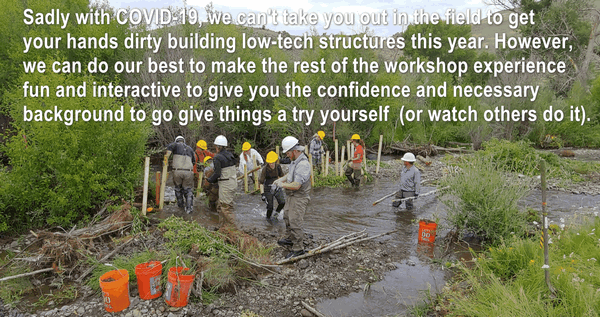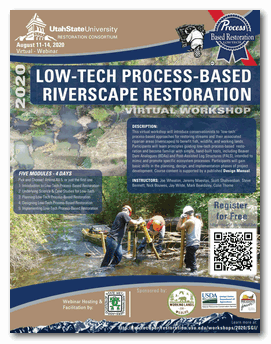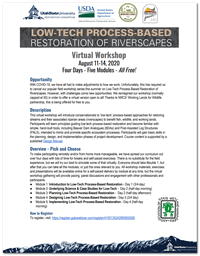2020 Virtual Workshop
August 11–14, 2020 - Anywhere with Internet — Completed
Overview
Thanks to the generous support of the Natural Resource Conservation Service's Working Lands for Wildlife and a grant through Pheasants Forever to Utah State University's Restoration Consortium and Joe Wheaton's ET-AL lab, we were able to deliver a free virtual workshop to NRCS conservationists and their partners. This series was envisioned by Jeremy Maestas (NRCS) and was made possible thanks to partner matches by various local organizations and matching funds from Utah State University. This workshop grew out of the successful 2016 Enhancing Mesic Habitat Resilience in Sagebrush Ecosystems Workshop and the 2018 and 2019 series.
Odd 2020 Opportunity
With COVID-19, the field workshop series was canceled. However, we adapted to offer a virtual version open to all! Thanks to NRCS’s Working Lands for Wildlife partnership, it was offered for free.

Virtual Workshop Description
This virtual workshop introduced conservationists to low-tech process-based approaches for restoring streams and their associated riparian areas to benefit fish, wildlife, and working lands. Participants learned principles guiding low-tech process-based restoration and became familiar with Beaver Dam Analogues (BDAs) and Post-Assisted Log Structures (PALS). Participants gained skills in planning, design, and implementation of projects.
Overview - Pick and Choose
We spread the curriculum over four days with breaks and self-paced exercises. All workshop materials, exercises, and presentations were made available for self-paced delivery, with the virtual gathering providing pacing and engagement.
Agenda
- Module 1: Introduction - Day 1, August 11
- Module 2: Underlying Science & Case Studies - Day 2, August 12
- Module 3: Planning - Day 2, August 12
- Module 4: Design - Day 3, August 13
- Module 5: Implementation - Day 4, August 14
Registration
Registration was free, but is now closed. Participation was limited to 1000 participants.
Course Materials
Workshop Textbooks
Mandatory Texts: A hard copy of both the manual and pocket guide was recommended, but free digital versions are available:
- Wheaton J.M. et al. 2019. Low-Tech Process-Based Restoration of Riverscapes: Design Manual. DOI: 10.13140/RG.2.2.19590.63049/2
- Wheaton J.M. et al. 2019. Low-Tech Process-Based Restoration of Riverscapes: Pocket Field Guide. DOI: 10.13140/RG.2.2.28222.13123/1
Print copies of the manual can be purchased on Amazon or BookBaby. Waterproof versions of the pocket guide are available here.
More Background
Through SGI 2.0, NRCS is working with landowners and partners to protect and restore mesic habitats.
BDAs are increasingly popular bioengineering tools designed to mimic beaver activity to restore hydrologic function in incised channels. They have shown promise in achieving riparian goals cost-effectively.
Purpose & Need
There is a need to convene interdisciplinary staff to evaluate low-cost, low-risk techniques that can be scaled to meet mesic habitat restoration goals. Participants gained knowledge and skills needed to design and implement these practices.
Instruction Team
The team included experts like:
- Mark Beardsley
- Stephen Bennett
- Nicolaas Bouwes
- Ben Goldfarb
- Jeremy Maestas
- Scott Shahverdian
- Colin Thorne
- Nick Weber
- Joseph Wheaton
Instructor Affiliations
- Utah State University
- Anabranch Solutions
- Eco Logical Research
- EcoMetrics
- USDA NRCS
- University of Nottingham
Audience
The virtual field workshop was aimed at anyone interested in improving riverscapes with low-tech PBR approaches: practitioners, land/resource managers, scientists, landowners, regulators, conservationists, and students.
For Field Workshops
For field workshops, participation was generally by invitation, targeting NRCS staff and key partners with a cap of ~45 participants per site to keep exercises effective.
Make it Count
Participation was free. However, participants could earn university credit or continuing education units through Utah State University's Restoration Consortium. Online courses were offered in Fall 2020, and participation in the virtual workshop could count toward those credits (with assessed assignments).



